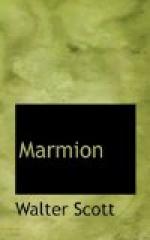’Underneath this
sable herse
Lies the subject
of all verse.’
line 203. The ‘Border Minstrel’ is an appropriate designation of the author of ‘Contributions to the Minstrelsy of the Scottish Border’ and the ‘Lay of the Last Minstrel.’ In the preface to the latter work, written in 1830, Scott refers to the two great statesmen as having ‘smiled on the adventurous minstrel.’ This is the only existing evidence of Fox’s appreciation. Pitt’s praise of the Lay his niece, Lady Hester Stanhope, reported to W. S. Rose, who very naturally passed it on to Scott himself. The Right Hon. William Dundas, in a letter to Scott, mentions a conversation he had had with Pitt at his table, in 1805, and says that Pitt both expressed his desire to advance Scott’s professional interests and quoted from the Lay the lines describing the embarrassment of the harper when asked to play. ‘This,’ said he, ’is a sort of thing which I might have expected in painting, but could never have fancied capable of being given in poetry.’—Lockhart’s Life of Scott, ii. 34.
line 204. Gothic. This refers to both subject and style, neither being classical.
line 220. Lockhart quotes from Rogers’s ’Pleasures of Memory’:—
’If but a beam
of sober reason play,
Lo! Fancy’s
fairy frostwork melts away.’
lines 233-48. In these lines the poet indicates the sphere in which he had previously worked with independence and success. Like Virgil when proceeding to write the AEneid, he is doubtful whether his devotion to legendary and pastoral themes is sufficient warrant for attempting heroic verse. The reference to the tales of shepherds in the closing lines of the passage recalls the advice given (about 1880) to his students by Prof. Shairp, when lecturing from the Poetry Chair at Oxford. ‘To become steeped,’ he said, ’in the true atmosphere of romantic poetry they should proceed to the Borders and learn their legends, under the twofold guidance of Scott’s “Border Minstrelsy” and an intelligent local shepherd.’
line 256. steely weeds = steel armour. ‘Steely’ in Elizabethan times was used both literally and figuratively. Shakespeare, 3 Henry vi. ii. 3. 16, has ‘The steely point of Clifford’s lance,’ and Fisher in his ‘Seuen Psalmes’ has ‘tough and stely hertes.’ For a modern literal example, see Crabbe’s ’Parish Register’:—
’Steel through
opposing plates the magnet draws,
And steely
atoms calls from dust and straws.’
Weeds in the sense of dress is confined, in modern English, to widows’ robes. In Elizabethan times it had a general reference, as e.g. Spenser’s ‘lowly Shephards weeds’ in the Introduction to ’Faery Queene.’ Cp. below, Canto V. line 168, vi. line 192.
line 258. The Champion is Launcelot, the most famous of King Arthur’s Knights of the Round Table. See Tennyson’s ’Idylls of the King,’ especially ‘Lancelot and Elaine,’ and William Morris’s ‘Defence of Guenevere.’




